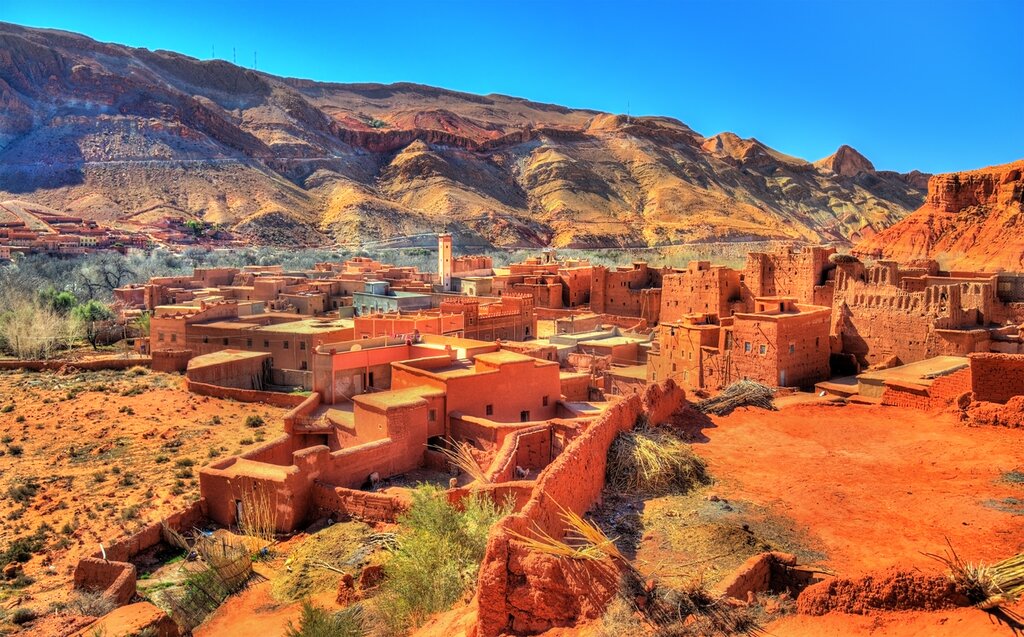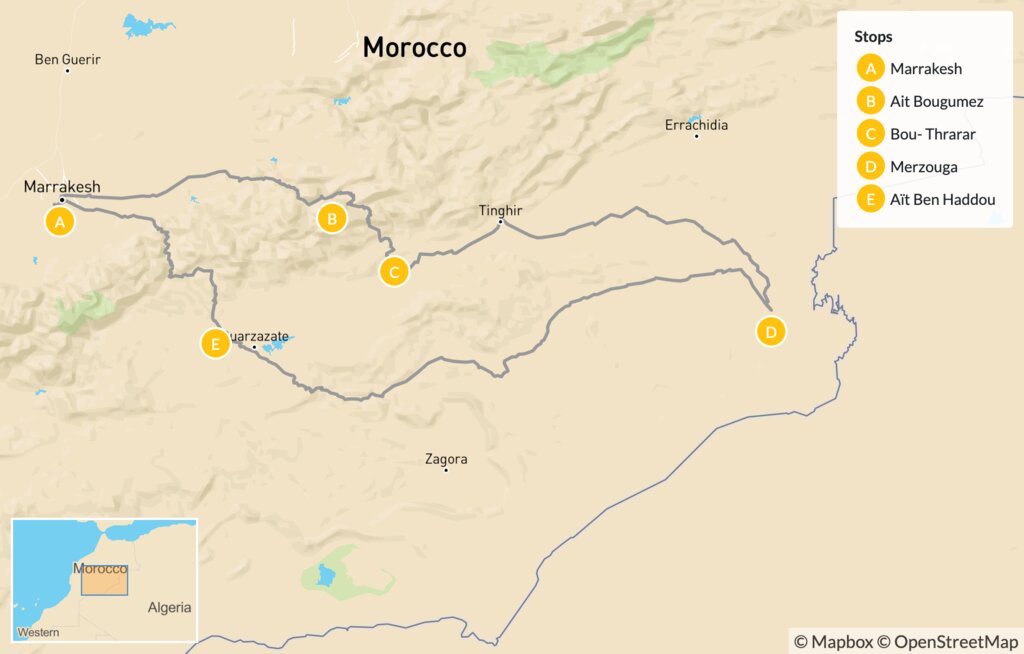Highlights
- Browse the souks of Marrakesh on a guided tour
- Spend time with local families in Berber villages
- Visit a women's co-op and farm with locals in Boutaghrar
- Hike the Valley of the Roses and tour villages in the Sahara
Brief Itinerary
| Day | Highlights | Overnight |
|---|---|---|
| Day 1 | Arrive in Marrakesh | Marrakesh |
| Day 2 | Transfer to Aït Bouguemez Valley | Aït Bouguemez |
| Day 3 | Berber Culture & NGO Volunteering | Aït Bouguemez |
| Day 4 | Visit Tabant | Aït Bouguemez |
| Day 5 | Transfer to the Valley of the Roses | Bou Thrarar |
| Day 6 | Valley of the Roses Hike, Farming in Bou Thrarar | Bou Thrarar |
| Day 7 | Transfer to Merzouga, Sahara Towns & Camel Ride | Merzouga |
| Day 8 | Sahara Eco-Adventure With Local NGO | Merzouga |
| Day 9 | Transfer to Aït Benhaddou via Dadès Valley | Aït Benhaddou |
| Day 10 | Transfer to Marrakesh, Visit Main Square | Marrakesh |
| Day 11 | Guided Tour of Marrakesh | Marrakesh |
| Day 12 | Depart Marrakesh |
Detailed Itinerary
Day 1: Arrive in Marrakesh

Day 2: Transfer to Aït Bouguemez Valley

Enjoy a leisurely breakfast in your riad, then meet your driver for today's five-hour ride into Aït Bouguemez. Known as the "Happy Valley," this region is the gateway to the dramatic Atlas mountains and has been home to Berber villages for centuries. After leaving Marrakesh, the vast plains will give way to mountain valleys as you make your way to Azilal, a provincial capital in central Morocco. In the heart of this area is the UNESCO M'Goun Conservation Area, the first geopark of Morocco. It's an exceptional geologic site, rich in minerals and boasting dinosaur skeletons dating back to the Triassic Period.
Continue on to Aït Bouguemez, taking time to visit the Ouzoud Falls and the natural bridge of Imi N'Ifri, which are both in M'Goun. You'll arrive in the valley via a high mountain road, and once there, you'll drive to a local ecolodge. Here, you'll be welcomed with a cup of hot tea, a symbol of hospitality from the Berbers of the High Atlas. After checking in at the lodge, you'll head out on foot to visit nearby Berber villages comprised of adobe homes with irrigated terraces.
Day 3: Berber Culture & NGO Volunteering

Day 4: Visit Tabant
Chat with a local specialist who can help organize your trip.

Experience more local culture as you visit highlights around Aït Bouguemez, like the market town of Tabant. Located in a hidden valley, it's famous for being home to the tombs of holy men. Perched atop a conical hill above the town is a shrine to one of them, Sidi Moussa (Lord Moses), a pious tribesman reputed to possess supernatural healing powers. The shrine also doubles as a museum showcasing traditional crafts, plus it offers panoramic views of Aït Bouguemez and the surrounding mountains. Later, you'll return to R’bat and enjoy a henna ceremony followed by traditional music and dancing.
Day 5: Transfer to the Valley of the Roses

Eventually, you'll reach the pretty village of Bou Thrarar. Here, your driver will take you to a local ecolodge, and you'll have time to relax after check-in.
Day 6: Valley of the Roses Hike, Farming in Bou Thrarar

Early this morning, set out to discover the beauty and culture of this remarkable region on a guided walking tour. Over three hours, you'll hike through green oases in the Atlas foothills, passing humble Berber villages along the way. Stop periodically to chat with local families and learn a bit more about the way of life in this part of the world. It's also a great opportunity to hear fascinating tales of local history.
After the hike, you'll visit a farming community in the Valley of the Roses. The villagers here are renowned for their hospitality, and they'll happily welcome you and show off the fields where they cultivate fruits, vegetables, and grains. Over the course of two hours, you'll get your hands dirty, so to speak, helping out on the farm. Besides harvesting crops and feeding animals like goats and cows, you'll also learn about ancient irrigation techniques. And at the end of the day, do like the locals and enjoy a cup of mint tea with olive oil and bread right on the farm.
Day 7: Transfer to Merzouga, Sahara Towns & Camel Ride

As you continue down the road, you'll see the waving sands of Erg Chebbi—an expansive set of dunes covering almost 14 square miles (35 sq km). Then, just outside Merzouga, you'll stop for an unforgettable camel ride through the Sahara. Afterward, get back in the car and reach your luxury eco-camp just before sunset. Once you've settled into your tent, climb up the nearest dune to watch the setting sun cast vivid colors and dark shadows across the sands. Then, enjoy dinner by the campfire accompanied by traditional Berber music.
Day 8: Sahara Eco-Adventure With Local NGO

Today, you'll immerse yourself in the fascinating culture of the Sahara desert. During this five-hour adventure/volunteer project, you'll also give back through various service projects that will leave a lasting impact on Berber and Arab residents who make up the community. It's a great cultural exchange, too, as the people here are known for their kindness and generosity and will be happy to share their centuries-old culture with you.
You'll be spending the day with a local NGO that plays a large role in the community by helping to reduce waste, improve access to education for both genders, and lower illiteracy and poverty. To this end, you'll meet with local nomads to provide them with food and clothing. You'll also get to know them personally, hear their stories, and spend valuable time with their kids as you teach some English and play games with them.Then, you're off to the village of Khamleya to listen to live performances of Gnawa, the traditional healing music of the Sahara. At its core, Gnawa is spiritual and personal, yet it's also achieved mainstream success due to the efforts of popular maâlems (master musicians). The music is denoted by lively drum beats performed by a maâlem with the backing of musicians and dancers. Afterward, you'll return to camp in time for another sunset. Climb the dunes once again and watch as the setting sun casts the sand in vivid hues of red and gold.
Day 9: Transfer to Aït Benhaddou via Dadès Valley

Your driver will pick you up for the 5.5-hour drive to Aït Benhaddou after breakfast. This village, comprised of earthen buildings, is situated on the ancient caravan route between the Sahara and Marrakesh, and it's so historic that it enjoys UNESCO World Heritage status. You'll break up the drive by stopping at a few regional highlights. You'll also have some free time before you leave, during which you can spend sandboarding or on an ATV tour.
Your first stop once you hit the road is Khamleya, an authentic Saharan village populated by people originally from Mali. Feel free to take a walk around the village and enjoy traditional live music and dancing afterward. Then, you'll pass through the Valley of a Thousand Kasbahs. The kasbahs (defense fortresses) here date back hundreds of years, and many in this region of Morocco are in disrepair, as they were built with adobe.
You'll then enter the Dadès Valley, where plots of farmland are fringed with rose bushes, the flowers of which are used to make perfumed water and oil. Your next stop is the picturesque town of Ouarzazate. A former French protectorate, It's known as Morocco's Hollywood due to its sprawling deserts and palm-lined roads, which have been featured in several Hollywood productions, including "Lawrence of Arabia," "Gladiator," and "Game of Thrones." After touring Ouarzazate, you'll continue about 30 minutes to Aït Benhaddou, where you'll spend the night.
Day 10: Transfer to Marrakesh, Visit Main Square

In the morning, you'll make the four-hour drive northwest from Aït Benhaddou to Marrakesh. The route follows mountain roads in the High Atlas, and the first town you'll arrive at after crossing over the scenic Tizi n'Tichka Pass pass is Taddert. Here, you can stop for a tour to see the inner workings of an olive-oil cooperative. After tasting a few products, you'll leave the mountains behind as you descend into the foothills and deserts before reaching Marrakesh.
Once there, check in to your hotel and spend some time relaxing before hitting the town in the early evening. This is when Jemaa el-Fna, the main square, comes alive with musicians, performers, snake charmers, games, food stalls, and more. Wander around the plaza and browse the vendor stalls, or pull up a seat in a nearby café for highly entertaining people-watching.
Day 11: Guided Tour of Marrakesh

Today you'll embark on a 5.5-hour guided tour to discover Marrakesh's captivating sights, sounds, and smells. Start with a visit to the beautiful courtyard and gardens of the 19th-century Bahia Palace, then continue to the Koutoubia Mosque, which dates to 1147. Afterward, pass through the medina's historic gates and meander through twisting alleyways amid souks (markets) and hidden fondouks (historic inns). Later, head to Jemaa el-Fna Square, the city's landmark plaza filled with market stalls, street food vendors, and performers.
During the tour, your expert local guide will take you to a few of the best souks. You'll see the famed spice towers at Souk el Attarine and shop for handmade babouche slippers at Souk Smata. Then visit Souk des Teinturiers, where you can watch locals dyeing and hanging cloth and yarn. In the evening, follow your nose back to the delicious food stalls in Jemaa el-Fna Square. Or, if you prefer a quieter eating experience, choose one of the many rooftop cafés above the square and watch the action below.
Day 12: Depart Marrakesh



